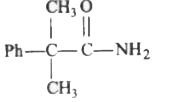Beckmann rearrangement.
Oximes on heating in presence of an acid yield substituted amides.
Topper's Solved these Questions
Similar Questions
Knowledge Check
Which of the following compounds cannot give Hofmann rearrangement?
A B
B C
C D
D
Which of the following species would not be involved in the Hoffmann rearrangement shown below?
 A
A B
B C
C DAll of the above are involved in the reaction.
DAll of the above are involved in the reaction.Di-tert-glycols rearrange in the presence of acid to give alpa-tertiary ketones. The trivial name of the simplest glycol of this type is pinacol, and this type of reaction therefore is named pinacol rearrangement (in this specific case, the reaction is called a pinacol-pinacolone rearrangement). The rearrangement involves 4 steps. one of the hydroxyl groups is protonated in the first step. A molecule of water is eliminated in the second step and a tertiary carbocation is formed. The carbocation rearranges in the third step into a more stable carboxonium ion via a [1,2] rearrangement. In the last step, the carboxonium ion is deprotonated and the product ketone is obtained.

What is R.D.S. of pinacol-pinacolone rearrangement?AI stepBII stepCIII stepDIV step
Cope rearrangement
View SolutionCope rearrangement
View SolutionAmong the following which one does not act as an intermediate in hofmann rearrangement
View SolutionIn which of the following reactions, rearrangement is possible ?
View SolutionDi-tert-glycols rearrange in the presence of acid to give alpa-tertiary ketones. The trivial name of the simplest glycol of this type is pinacol, and this type of reaction therefore is named pinacol rearrangement (in this specific case, the reaction is called a pinacol-pinacolone rearrangement). The rearrangement involves 4 steps. one of the hydroxyl groups is protonated in the first step. A molecule of water is eliminated in the second step and a tertiary carbocation is formed. The carbocation rearranges in the third step into a more stable carboxonium ion via a [1,2] rearrangement. In the last step, the carboxonium ion is deprotonated and the product ketone is obtained.


How many products obtained in above reaction?
View Solution

